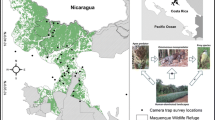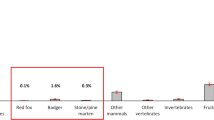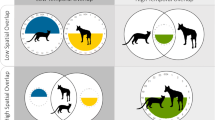Abstract
Mammalian carnivores are elusive and enigmatic species that often play keystone roles in ecosystems through direct and indirect effects. Growing evidence shows that human activity can impact carnivore behavior and community structure by altering predator-prey interactions, shifting diel activity patterns, and altering wildlife movement. Our goal was to investigate the ecological role of bobcats (Lynx rufus) across carnivore communities in the continental USA by quantifying variation in spatiotemporal patterns and determining what environmental and human factors influenced carnivore community interactions. Using camera trap data from the inaugural nationwide Snapshot USA project dataset collected from September – October 2019, we constructed diel activity density curves, applied multispecies occupancy models, and calculated attraction-avoidance ratios. Our results suggest that bobcats display the greatest flexibility in their diel activity among the suite of carnivores sampled. Further, bobcats respond differentially at large spatial scales relative to the presence of dominant or subordinate carnivores, with fluctuating impacts mediated by human and environmental factors. Bobcats’ co-occurrence with dominant carnivores (i.e., wolves Canis sp., pumas Puma concolor) was influenced primarily by human-related factors, whereas co-occurrence with subordinate carnivores (i.e., foxes) was more influenced by environmental factors (i.e., precipitation, gross primary production [GPP]). Bobcats appear to interpret humans as the apex predator on the landscape regardless of the presence of dominant or subordinate species. Understanding the influence of humans as “super predators’’, as well as the importance of environmental factors that impact intraguild carnivore interactions across the USA is critical for establishing successful management practices to promote functioning communities.




Similar content being viewed by others
Data Availability
All data from this manuscript has been archived as part of Snapshot USA 2019 available at https://doi.org/10.1002/ecy.3353.
References
Agostinelli C, Lund U (2017) Circular Statistics. Package ‘circular’. https://cran.rproject.org/web/packages/circular/circular.pdf
Allen ML, Elbroch LM, Wilmers CC, Wittmer HU (2015) The Comparative Effects of Large Carnivores on the Acquisition of Carrion by Scavengers. Am Nat 185:822–833. https://doi.org/10.1086/681004
Breck SW, Poessel SA, Mahoney P, Young JK (2019) The intrepid urban coyote: a comparison of bold and exploratory behavior in coyotes from urban and rural environments. Sci Rep 9:2104. https://doi.org/10.1038/s41598-019-38543-5
Burnham KP, Anderson DR (2002) Model Selection and Inference: A Practical Information-Theoretic Approach. 2nd Edition, Springer-Verlag, New York. https://doi.org/10.1007/b97636
Clinchy M, Zanette LY, Roberts D et al (2016) Fear of the human “super predator” far exceeds the fear of large carnivores in a model mesocarnivore. Behav Ecol 27:1826–1832. https://doi.org/10.1093/beheco/arw117
Cove MV, Jones BM, Bossert AJ et al (2012) Use of Camera Traps to Examine the Mesopredator Release Hypothesis in a Fragmented Midwestern Landscape. Am Midl Nat 168:456–465. https://doi.org/10.1674/0003-0031-168.2.456
Cove MV, Kays R, Bontrager H, et al (2021) SNAPSHOT USA 2019: a coordinated national camera trap survey of the United States. Ecol e03353. https://doi.org/10.1002/ecy.3353
Davies TJ, Meiri S, Barraclough TG, Gittleman JL (2007) Species co-existence and character divergence across carnivores. Ecol Lett 10:146–152. https://doi.org/10.1111/j.1461-0248.2006.01005.x
Dellinger JA, Shores CR, Marsh M et al (2018) Impacts of recolonizing gray wolves (Canis lupus) on survival and mortality in two sympatric ungulates. Can J Zool. https://doi.org/10.1139/cjz-2017-0282
Dormann CF, Elith J, Bacher S et al (2013) Collinearity: a review of methods to deal with it and a simulation study evaluating their performance. Ecography 36:27–46. https://doi.org/10.1111/j.1600-0587.2012.07348.x
Dröge E, Creel S, Becker M, M’soka J (2016) Spatial and temporal avoidance of risk within a large carnivore guild. Ecol and Evol 7:189–199. https://doi.org/10.1002/ece3.2616
Duncan N, Asher O, Weckel M et al (2020) Baseline diet of an urban carnivore on an expanding range front. J of Urban Ecol 6. https://doi.org/10.1093/jue/juaa021
Elbroch LM, Robertson L, Combs K, Fitzgerald J (2017) Contrasting bobcat values. Biodivers and Conserv 26:2987–2992. https://doi.org/10.1007/s10531-017-1397-6
Environmental Protection Agency (2016) Level I Ecoregions Regions of North America. https://www.epa.gov/eco-research/ecoregions-north-america
Excel VBA, Translation (2021) Peltier Tech Blog. https://peltiertech.com/
Fiske I, Chandler R (2011) unmarked: An R Package for Fitting Hierarchical Models of Wildlife Occurrence and Abundance. J of Stat Softw 43:1–23. https://www.jstatsoft.org/v43/i10/
Frey S, Fisher JT, Burton AC, Volpe JP (2017) Investigating animal activity patterns and temporal niche partitioning using camera-trap data: challenges and opportunities. Remote Sens in Ecol and Conserv 3:123–132. https://doi.org/10.1002/rse2.60
Gompper ME, Lesmeister DB, Ray JC et al (2016) Differential Habitat Use or Intraguild Interactions: What Structures a Carnivore Community? PLoS ONE 11:e0146055. https://doi.org/10.1371/journal.pone.0146055
Grassel SM, Rachlow JL, Williams CJ (2015) Spatial interactions between sympatric carnivores: asymmetric avoidance of an intraguild predator. Ecol and Evol 5:2762–2773. https://doi.org/10.1002/ece3.1561
Green DS, Matthews SM, Swiers RC et al (2018) Dynamic occupancy modelling reveals a hierarchy of competition among fishers, grey foxes and ringtails. J of Anim Ecol 87:813–824. https://doi.org/10.1111/1365-2656.12791
Ghoddousi A, Soofi M, Hamidi AK, Lumetsberger T, Egli L, Ashayeri S, Khorozyan IH, Kiabi B, Waltert M (2017) When pork is not on the menu: Assessing trophic competition between large carnivores and poachers. Biol Conserv 209:223–229. https://doi.org/10.1016/j.biocon.2017.02.032
Herrera DJ, Moore SM, Flockhart DT, McShea WJ, Cove MV (2021) Thinking outside the park: recommendations for camera trapping mammal communities in the urban matrix. J Urban Ecol 7. https://doi.org/10.1093/jue/juaa036
Hutchinson GE(1957) Concluding remarks. – Cold Spring Harb. Symp. Quant Biol 22:145– 159
Johnson SA, Walker HD, Hudson CM (2010) Dispersal Characteristics of Juvenile Bobcats in South-Central Indiana. The J of Wildl Management 74:379–385. https://doi.org/10.2193/2008-253
Kays R, Lasky M, Allen ML, Dowler RC, Hawkins MT, Hope AG, Cove MV (2022) Which mammals can be identified from camera traps and crowdsourced photographs? J Mammal. https://doi.org/10.1093/jmammal/gyac021
Kays R, Parsons AW, Baker MC et al (2017) Does hunting or hiking affect wildlife communities in protected areas? J of Appl Ecol 54:242–252. https://doi.org/10.1111/1365-2664.12700
Laliberte AS, Ripple WJ (2004) Range Contractions of North American Carnivores and Ungulates. BioSci 54:123–138. https://doi.org/10.1641/0006-3568(2004)054[0123:RCONAC]2.0.CO;2
Lashley MA, Cove MV, Chitwood MC et al (2018) Estimating wildlife activity curves: comparison of methods and sample size. Sci Rep 8:1–11. https://doi.org/10.1038/s41598-018-22638-6
Lesmerises F, Dussault C, St-Laurent M-H (2013) Major roadwork impacts the space use behaviour of gray wolf. Landsc and Urban Plan 112:18–25. https://doi.org/10.1016/j.landurbplan.2012.12.011
Linnell JDC, Strand O (2000) Interference interactions, co-existence and conservation of mammalian carnivores. Divers Distrib 6:169–176. https://doi.org/10.1046/j.1472-4642.2000.00069.x
Lombardi JV, MacKenzie DI, Tewes ME et al (2020) Co-occurrence of bobcats, coyotes, and ocelots in Texas. Ecol and Evol 10:4903–4917. https://doi.org/10.1002/ece3.6242
López-Bao JV, Mattisson J, Persson J et al (2016) Tracking neighbours promotes the coexistence of large carnivores. Sci Rep 6:23198. https://doi.org/10.1038/srep23198
MacKenzie DI, Nichols JD, Hines JE et al (2003) Estimating Site Occupancy, Colonization, and Local Extinction When a Species Is Detected Imperfectly. Ecol 84:2200–2207. https://doi.org/10.1890/02-3090
Marrotte RR, Bowman J, Morin SJ (2020) Spatial segregation and habitat partitioning of bobcat and Canada lynx. FACETS 5:503–522. https://doi.org/10.1139/facets-2019-0019
Mazerolle MJ(2020) Model selection and multimodel inference based on (Q) AIC(c). Package ‘AICcmodavg’. https://cran.r-project.org/web/packages/AICcmodavg/AICcmodavg.pdf
McShea WJ, Forrester T, Costello R, He Z, Kays R (2016) Volunteer-run cameras as distributed sensors for macrosystem mammal research. Landsc Ecol 31:55–66. https://doi.org/10.1007/s10980-015-0262-9
Meredith M, Ridout M(2020) Estimates of coefficient of overlapping for animal activity patterns. Package ‘overlap’. https://cran.r-project.org/web/packages/overlap/overlap.pdf
Miller JRB, Pitman RT, Mann GKH et al (2018) Lions and leopards coexist without spatial, temporal or demographic effects of interspecific competition. J of Anim Ecol 87:1709–1726. https://doi.org/10.1111/1365-2656.12883
Monterroso P, Alves PC, Ferreras P (2014) Plasticity in circadian activity patterns of mesocarnivores in Southwestern Europe: implications for species coexistence. Behav Ecol Sociobiol 68:1403–1417. https://doi.org/10.1007/s00265-014-1748-1
Murphy A, Diefenbach DR, Ternent M et al (2021) Threading the needle: How humans influence predator-prey spatiotemporal interactions in a multiple-predator system. J of Anim Ecol 90:2377–2390. https://doi.org/10.1111/1365-2656.13548
Naidoo R, Burton AC (2020) Relative effects of recreational activities on a temperate terrestrial wildlife assemblage. Conserv Science and Pract 2:e271. https://doi.org/10.1111/csp2.271
Niedballa J, Sollmann R, Courtiol A, Wilting A (2016) camtrapR: an R package for efficient camera trap data management. Methods in Ecol and Evol 7:1457–1462. https://doi.org/10.1111/2041-210X.12600
Niedballa J, Wilting A, Sollmann R et al (2019) Assessing analytical methods for detecting spatiotemporal interactions between species from camera trapping data. Remote Sens in Ecol and Conserv 5:272–285. https://doi.org/10.1002/rse2.107
Palmer MS, Swanson A, Kosmala M et al (2018) Evaluating relative abundance indices for terrestrial herbivores from large-scale camera trap surveys. Afr J Ecol 56:791–803. https://doi.org/10.1111/aje.12566
Parsons AW, Bland C, Forrester T et al (2016) The ecological impact of humans and dogs on wildlife in protected areas in eastern North America. Biol Conserv 203:75–88. https://doi.org/10.1016/j.biocon.2016.09.001
Parsons AW, Forrester T, McShea WJ et al (2017) Do occupancy or detection rates from camera traps reflect deer density? J of Mammal 98:1547–1557. https://doi.org/10.1093/jmammal/gyx128
Poessel SA, Burdett CL, Boydston EE et al (2014) Roads influence movement and home ranges of a fragmentation- sensitive carnivore, the bobcat, in an urban landscape. Biol Conserv 180:224–232. https://doi.org/10.1016/j.biocon.2014.10.010
Rao JS, SenGupta A (2001) Topics in Circular Statistics, Sect. 7.5. World Scientific Press, Singapore
Ridout MS, Linkie M (2009) Estimating overlap of daily activity patterns from camera trap data. JABES 14:322–337. https://doi.org/10.1198/jabes.2009.08038
Ripple WJ, Estes JA, Beschta RL et al (2014) Status and Ecological Effects of the World’s Largest Carnivores. Science 343. https://doi.org/10.1126/science.1241484
Roberts NM, Crimmins SM (2010) Bobcat Population Status and Management in North America: Evidence of Large-Scale Population Increase. J of Fish and Wildl Management 1:169–174. https://doi.org/10.3996/122009-JFWM-026
Roemer GW, Gompper ME, Van Valkenburgh B (2009) The Ecological Role of the Mammalian Mesocarnivore. BioSci 59:165–173. https://doi.org/10.1525/bio.2009.59.2.9
Rose C, Prange IS, Landry SM (2020) Extirpated, immigrated, genetically stratified—first demographic assessment of a recovering bobcat (Lynx rufus) population after a century of extinction. Mamm Res 65:423–434. https://doi.org/10.1007/s13364-019-00462-1
Rota CT, Ferreira MAR, Kays RW et al (2016) A multispecies occupancy model for two or more interacting species. Methods in Ecol and Evol 7:1164–1173. https://doi.org/10.1111/2041-210X.12587
Rowcliffe JM, Kays R, Kranstauber B et al (2014) Quantifying levels of animal activity using camera trap data. Methods in Ecol and Evol 5:1170–1179. https://doi.org/10.1111/2041-210X.12278
Rowcliffe M(2021) Animal activity statistics. Package ‘activity’.https://cran.r-project.org/web/packages/activity/activity.pdf
R Core Team (2021) R: A language and environment for statistical computing. R Foundation for Statistical Computing, Vienna, Austria. https://www.R-project.org/
Ruiz-Villar H, Jubete F, Revilla E et al (2021) Like cat and fox: diurnal interactions between two sympatric carnivores in pastoral landscapes of NW Spain. Eur J Wildl Res 67:16. https://doi.org/10.1007/s10344-021-01469-3
Schmid F, Schmidt A (2006) Nonparametric estimation of the coefficient of overlapping - theory and empirical application. Comput Stat and Data Anal 50:1583–1596. https://doi.org/10.1016/j.csda.2005.01.014
Shores CR, Dellinger JA, Newkirk ES et al (2019) Mesopredators change temporal activity in response to a recolonizing apex predator. Behav Ecol 30:1324–1335. https://doi.org/10.1093/beheco/arz080
Smith JA, Suraci JP, Clinchy M et al (2017) Fear of the human ‘super predator’ reduces feeding time in large carnivores. Proc of the R Soc B: Biol Sciences 284:20170433. https://doi.org/10.1098/rspb.2017.0433
Smith JA, Wang Y, Wilmers CC (2015) Top carnivores increase their kill rates on prey as a response to human- induced fear. Proc of the R Soc B: Biol Sciences 282:20142711. https://doi.org/10.1098/rspb.2014.2711
Suraci JP, Clinchy M, Zanette LY, Wilmers CC (2019) Fear of humans as apex predators has landscape-scale impacts from mountain lions to mice. Ecol Lett 22:1578–1586. https://doi.org/10.1111/ele.13344
Wei T, Simko V(2017) Visualization of a correlation matrix. Package ‘corrplot’. https://cran.r-project.org/web/packages/corrplot/corrplot.pdf
Wang Y, Allen ML, Wilmers CC (2015) Mesopredator spatial and temporal responses to large predators and human development in the Santa Cruz Mountains of California. Biol Conserv 190:23–33. https://doi.org/10.1016/j.biocon.2015.05.007
Young JK, Golla J, Draper JP et al (2019) Space Use and Movement of Urban Bobcats. Anim 9:275. https://doi.org/10.3390/ani9050275
Acknowledgements
We acknowledge Snapshot 2019, which was a collaborative effort among scientists across the U.S.A. who contributed to the inaugural wildlife camera-trap survey producing a database accessible to the public. This project was financially supported by the Biology Department at Northern Michigan University. TH was supported by the NMU Biology Development Fund, the Spooner Student Research Fund, an Excellence in Education Grant, and a Student Technology Innovation Award.
Author information
Authors and Affiliations
Contributions
TH and DJRL conceived the idea and secured funding; All contributors collected data for Snapshot USA; TH led manuscript writing with technical assistance from MVC and DJRL. MLA and CN assisted with analysis of temporal activity. AMJ assisted with analysis of spatiotemporal avoidance. FI assisted with analysis of single and multispecies occupancy modeling. All authors reviewed and provided constructive feedback on the manuscript.
Corresponding author
Ethics declarations
Conflict of interest
The authors declare they have no conflicts of interest/no competing interests.
Additional information
Communicated by Adeline Loyau.
Publisher’s Note
Springer Nature remains neutral with regard to jurisdictional claims in published maps and institutional affiliations.
Rights and permissions
About this article
Cite this article
Hubbard, T., Cove, M.V., Green, A.M. et al. Human presence drives bobcat interactions among the U.S. carnivore guild. Biodivers Conserv 31, 2607–2624 (2022). https://doi.org/10.1007/s10531-022-02445-2
Received:
Revised:
Accepted:
Published:
Issue Date:
DOI: https://doi.org/10.1007/s10531-022-02445-2




